First off, congratulations on realizing that you can grow your own loofah sponge. Most people think they grow in the ocean alongside other sponges, like Mr. SquarePants. Growing loofah is easy in warm climates, but with this guide I'll show you that you can grow your own luffa sponge almost anywhere.
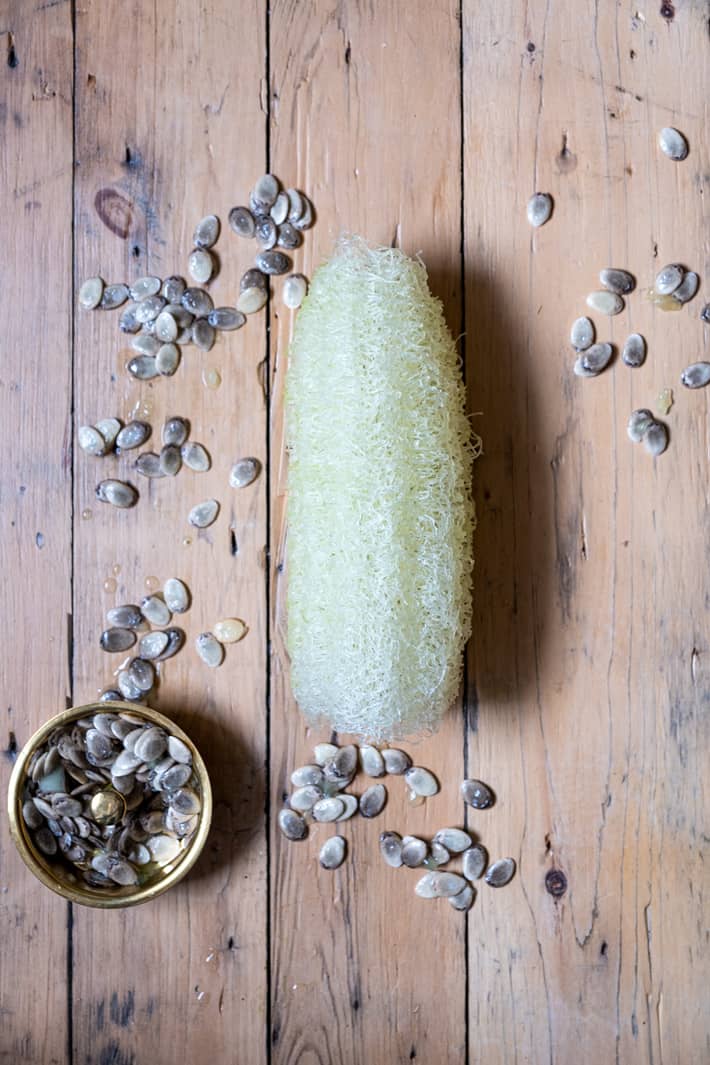
As a matter of fact, no they do not grow in the ocean. Or the sea. Or any other body of water.
The fact that loofah aka luffa is actually a vegetable is always the biggest shock to people when you tell them they can grow their own luffa sponges; the fact that they grow on land, not in the water.
Table of Contents
What IS a Loofah Plant
A loofah plant is a member of the Cucurbitaceae family like squash or cucumber. They have long growing vines that have fruit growing off of them. The plant produces edible fruit which become gourds when left on the vine to mature.
Those gourds dry as they get older, losing all their moisture. When cracked open all that is left inside are the fibres you recognize as a luffa sponge.
There are 2 species of this sponge producing plant.
- Luffa aegyptiaca (this is a smooth luffa, also known as Cylindra, Dishrag Gourd, Sponge Gourd, or Egyptian Cucumber)
- Luffa acutangula (this is a ridged luffa also known as Ridged Gourd, Angled Loofah or Chinese Okra)
They're all the same thing (edible vegetables that grow into fibrous sponges) with different names or a sightly different shape.
- Loofah plants are part of the gourd family and grow on vines that can get to be 30' long or more. Trust me on this.
- The part you're used to seeing is actually the inside fibres of the gourd, which lay beneath the green skin. That's the loofah sponge.
- Immature luffas look like a cucumber or zucchini and are edible when they're very young (4-8" long). They're traditionally eaten with eggs in Asian countries, like in this Serious Eats luffa recipe.
- They are annual vines and need to be replanted every year.
- Luffas are shitheads.
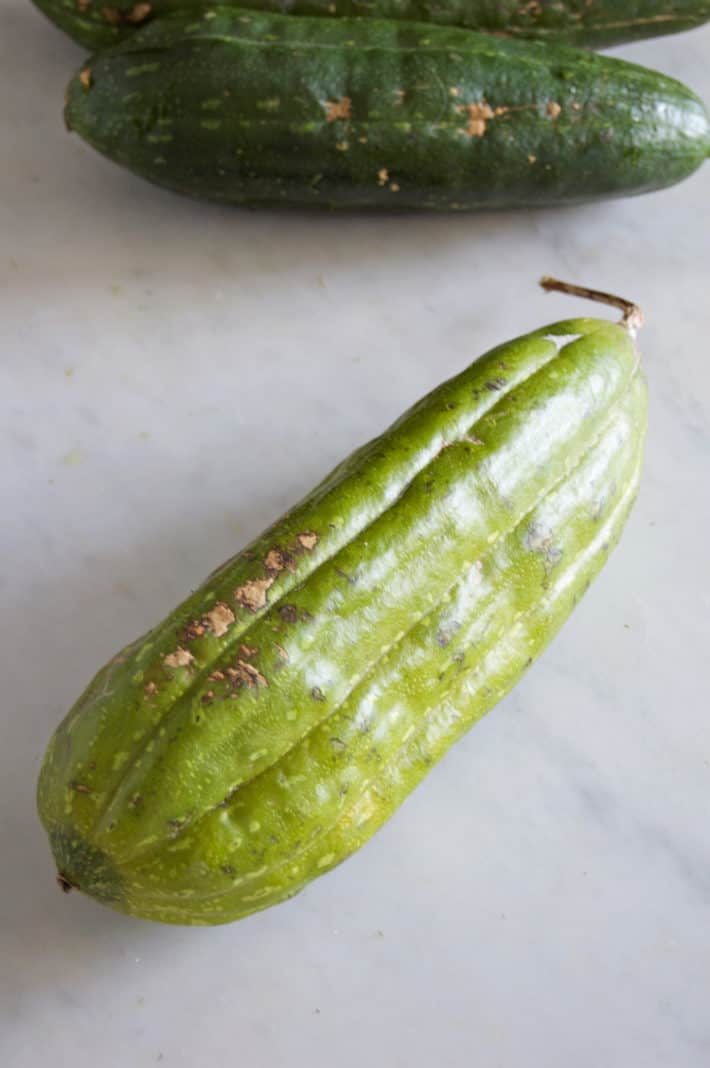
For the past decade I've been growing loofah in my Zone 6 climate. Each year more successfully than the previous year as I figure things out. They need a longggg growing season of 150-200 days. They are also easily frightened. Like you can frighten a Loofah to death.
More on that in a few moments.
To figure out how to successfully grow a loofah sponge, you have to know how to very, very unsuccessfully grow a loofah sponge.
Luckily for you, I have all kinds of experience in that particular area. In fact, I spent the better part of a decade being exceptionally unsuccessful at growing luffa.
Not to brag.
I now have it down to a science and you will now learn from my years of mistakes in this step-by-step guide.
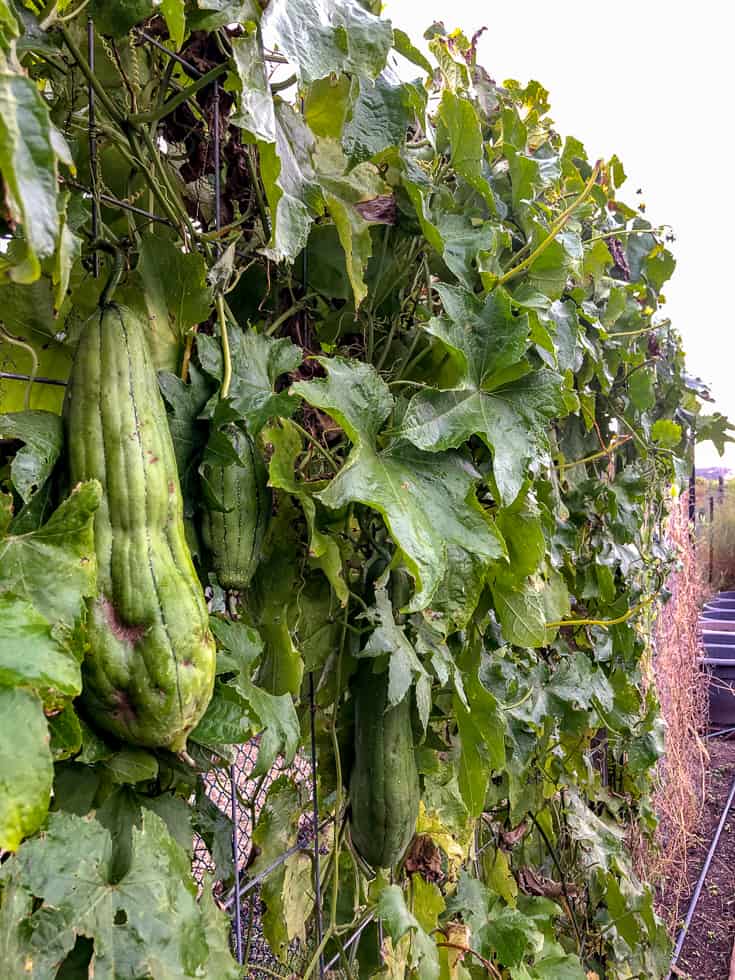
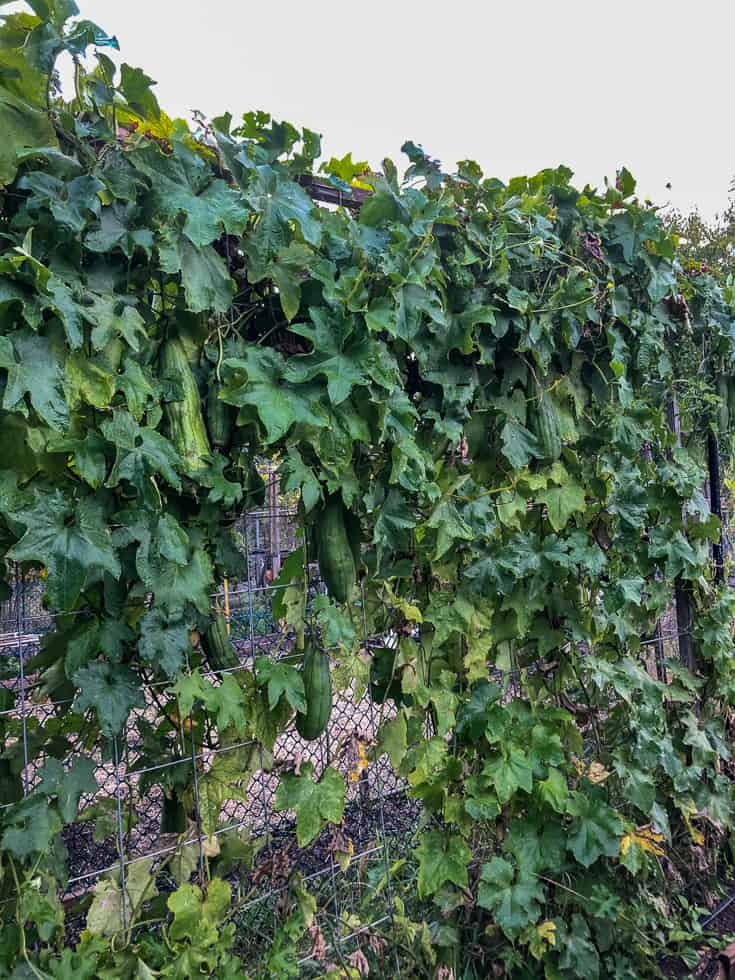
Growing loofah
In colder zones you need to start your plant from seed, grow it indoors until temperatures warm up and then plant it outside on a sturdy structure where the vines can do their thing and the heavy luffa fruit will have support.
Potential Problems
There are 3 main areas where things can go horribly wrong with growing the plant.
- Your seeds won't germinate. Because they're little asshead seeds that hate you.
- Your little luffa seedling goes into shock when you transplant it outside and it dies of fright or at least goes into a month long coma.
- Your vine grows but you never get to the point of seeing fruit before the frost kills it.
I'm going to show you how to overcome all of those issues so you can grow your own organic luffa sponge this summer.
Handy for showers, scrubbing pots and whacking people on the head with.
Planting luffa seeds
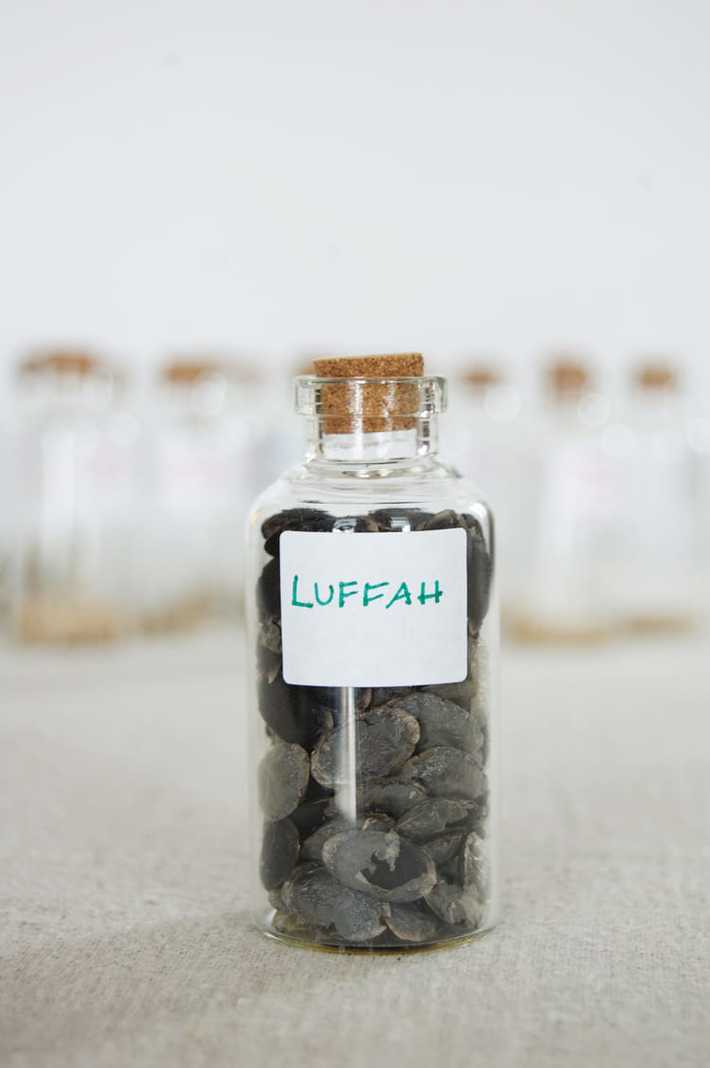
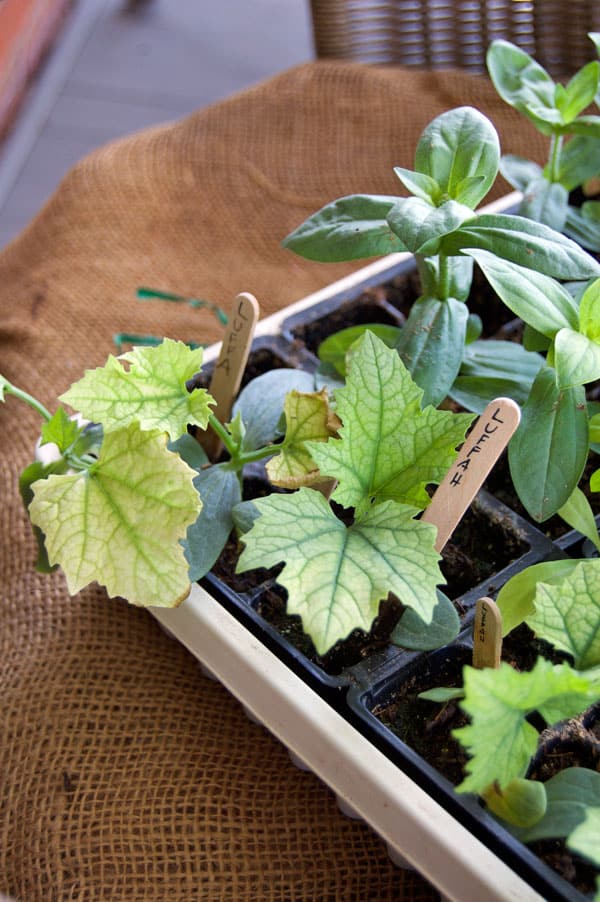
STEP 1 - If you're in a cooler zone, start your Luffa seeds early, indoors, 6 - 8 weeks before the last frost date.
STEP 2 - Use new Luffa seeds and soak them in water for 24 hours prior to planting. Seeds that have been hanging around for years won't germinate well.
STEP 3 - Sow seeds in a 4" pot of moistened soil. Plant ½" deep. Cover with plastic wrap, or a humidity dome just until the seeds sprout. Once sprouted you can remove the dome.
STEP 4 - Germinating luffa seeds on a seed heat pad will increase your success. Sow seeds and then place their pots or tray on the warmth heat pad to germinate.
STEP 5 - For an even BETTER chance of reducing transplant shock, grow in soil blocks instead of pots.
FINAL THOUGHT - Using this method your seeds should germinate within 3-10 days from planting.
TIP - I'm a soil block convert and you can read all about how they work and how to make them in my post on making soil blocks with a soil blocker.
Seed Heat mats
I can't overstate how much a seed heating mat improves germination and growth of your loofah seeds.
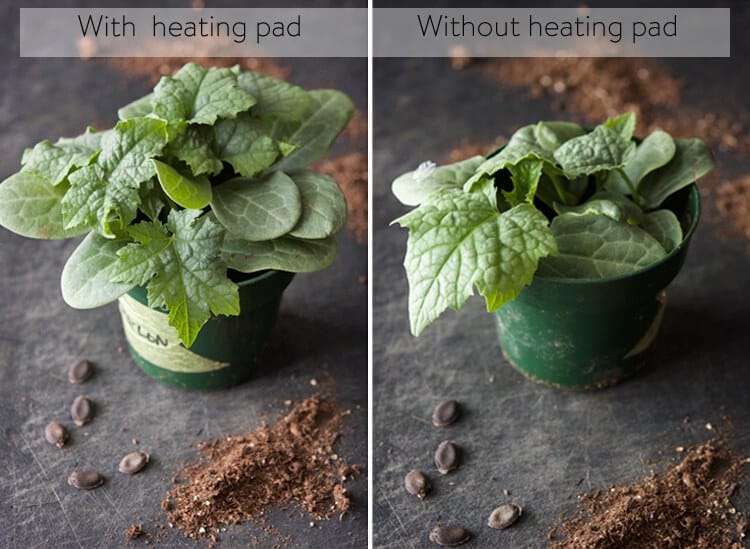
It's also working GREAT for my Sweet Potato slips using my updated sweet potato growing method, tomatoes and just about any other heat loving crop.
Planting out in the garden
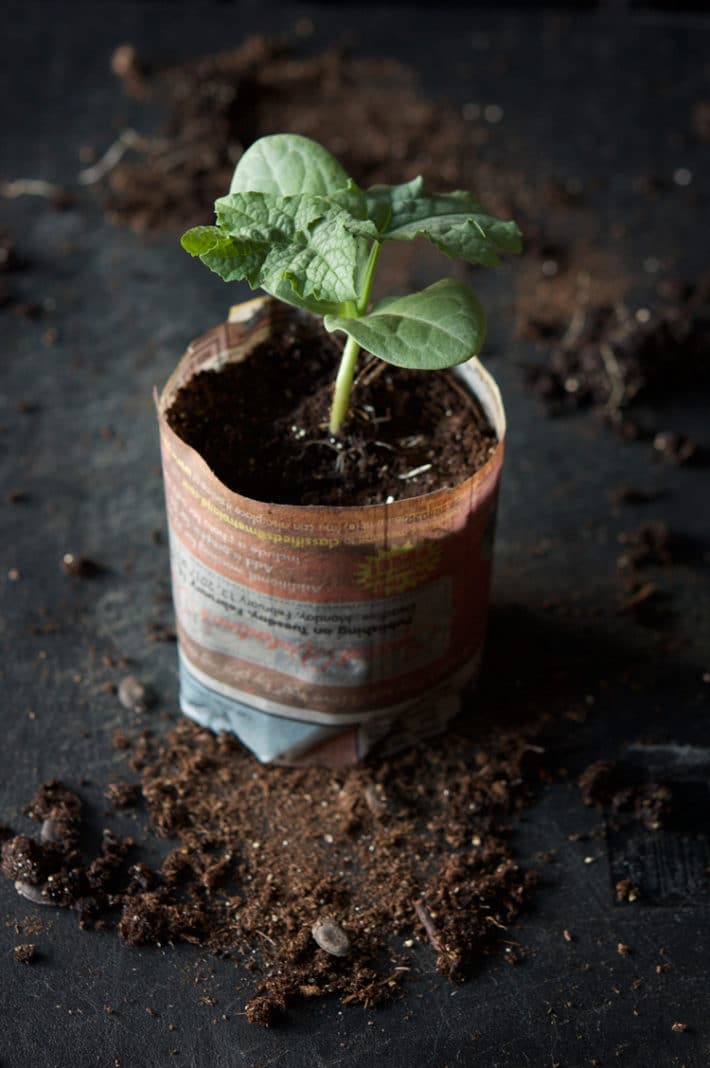
- When the weather is right ( air is consistently around 70 F or 21 C) start hardening off your seedlings. This is more important than with most other plants because Luffa are so prone to transplant shock.
- After a week or so of hardening off, plant your seedlings in an area that gets FULL sun. As much sun as possible. Anything less and you won't get any Luffas.
TIP - If you're unsure of what it is or how to do it, read these steps on how to harden off plants.
- Plant your loofah seedlings at the base of a strong structure that its vines can climb on and cling to. Chain link fence or something similar is perfect.
- If after planting out, a cold snap threatens, cover the seedlings with a vented cloche. Or you can cut the bottom off of a plastic pop bottle and place it over the plant (with the cap removed to allow venting). A few days of cold weather will STOP a luffa from growing and it could take a month before they get over the shock.
- Luffa will produce fruit 3 months after direct seeding, and 4 months after starting seeds inside. They are ready to harvest 6-7 months after seeding.
Alright then, you've started them from seed and planted them out. Now what do you do for the rest of the summer?
Growing Luffa in Containers
- You'll need a 25 - 30 gallon pot or grow bag. If you don't speak "gallons", just look for pots or grow bags that are about 20 - 24" across the top. This will ensure you don't have to water every 30 seconds, and it will hold enough soil to provide enough nutrients to the VERY large luffa.
- Grow one plant per bag. No more than that.
These are GREAT 30 gallon felt-like grow bags.
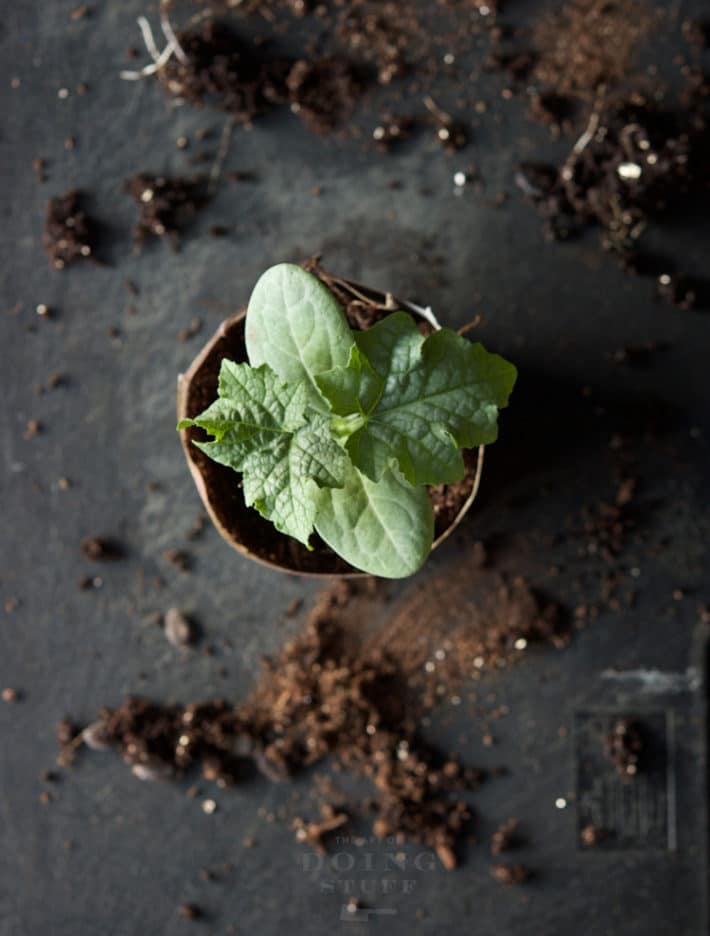
Growing on & summer care
Luffa take 6 - 7 months before they're mature and ready to harvest. That's how long you have to pay attention and take care of them.
Luckily it's mainly just a matter of watering, fertilizoing and keeping an eye out for pests.
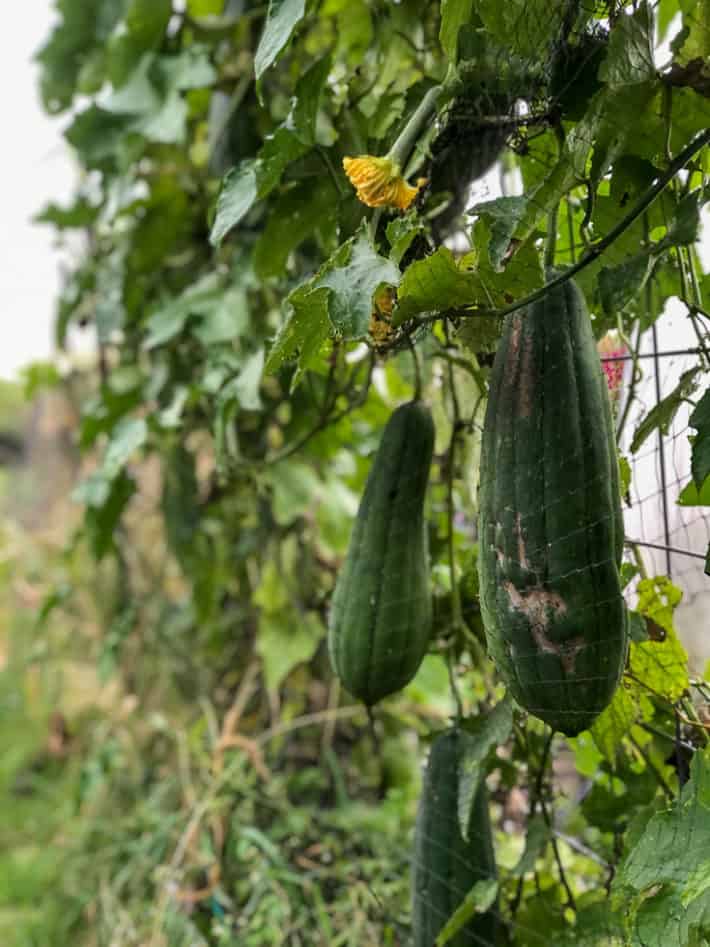
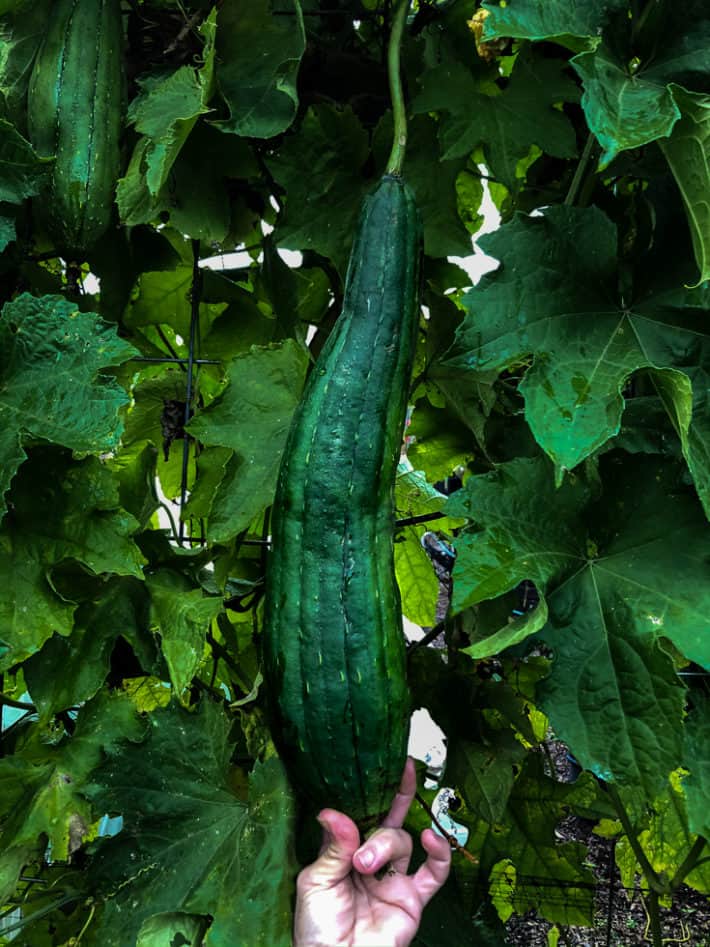
Watering
Keep the soil consistently moist. Don't let it dry out or get oversaturated. Luffa doesn't like surprises. It likes everything to stay the same.
Like I've mentioned before, luffa are shitheads that are plotting against you. If you let them dry out or overwater them, they will rebel against you.
Fertilizing
Before planting, apply 3" of compost over your bed or container.
You can also spring dress your beds with this organic 4-4-4 all purpose fertilizer from Gaia Green. (it's what I use)
Pollination
Like winter squash, luffa have male and female flowers. You can hand pollinate the female flowers using this hand pollination technique to increase your luffa harvest. This is especially helpful if you don't have a lot of pollinators in your garden.
Pinching
2 months before your first frost date (by the middle of August for me in zone 6) you need to pinch away all the flowers and any small luffa on the vine. Continue to do this for the rest of the season.
This is important because it will direct all the plant's remaining energy to growing the luffas that are on the vine now instead wasting it ones that have no chance of becoming harvest size. THIS IS CRUCIAL.
Pests & Diseases
Cucumber Beetle (which cause cucumber wilt)
Aphids
Squash Bug ← link to treatment
Vine Borers ← link to treatment
Powdery Mildew ← link to treatment
Blight
I have never lost a luffa plant to pests or disease, but these are the ones to watch out for. Where indicated I have a link to successful treatments I use.
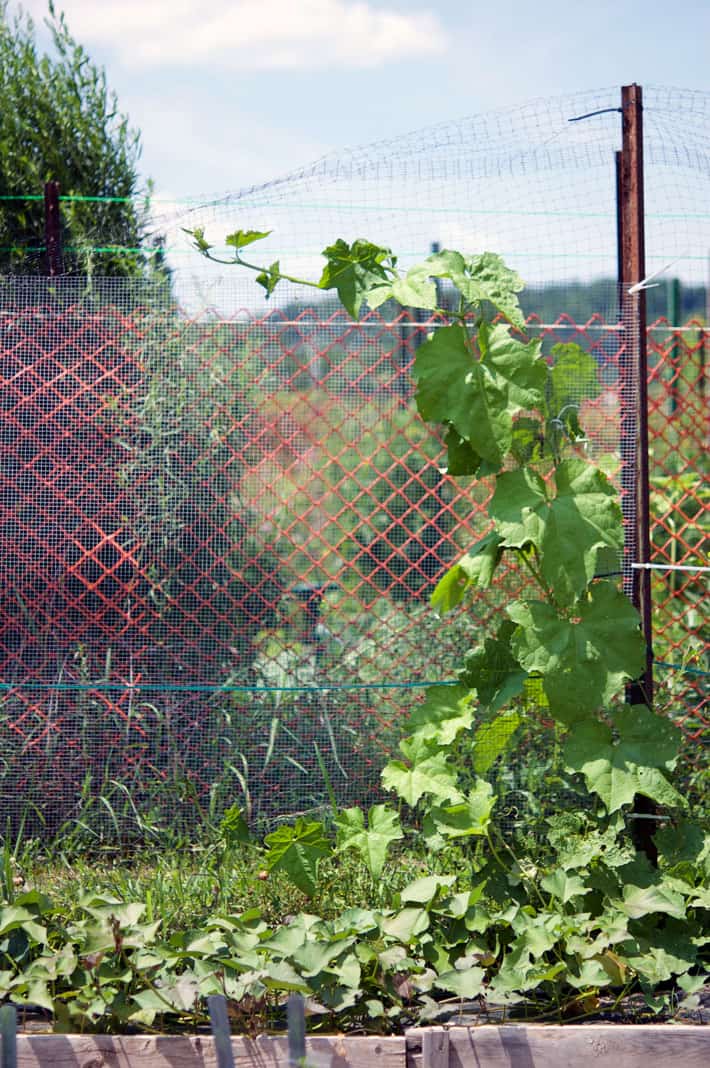
Harvesting
- By October you should have big Luffas. If you live in or above zone 7 your luffas will probably dry on the vine and be brown and light as a feather by October. For zone 6 and below they'll probably still be green. That's O.K.
- Pick your Luffa gourds BEFORE they're hit by frost even if they're still green.
Dry gourds vs Green gourds
Over and over you'll hear that you have to wait until the gourd is dry to pick it. And yes, that's the best time to pick it but it's not the only time.
If you live in zone 6 or below chances are you'll be harvesting them green. The lighter they feel in your hand, the greater chance they'll have fibres inside.
Some green luffas you pick will not have matured enough and when you peel them they'll be fleshy and gooey inside.
But OTHERS will indeed have developed enough to have the coveted fibres.
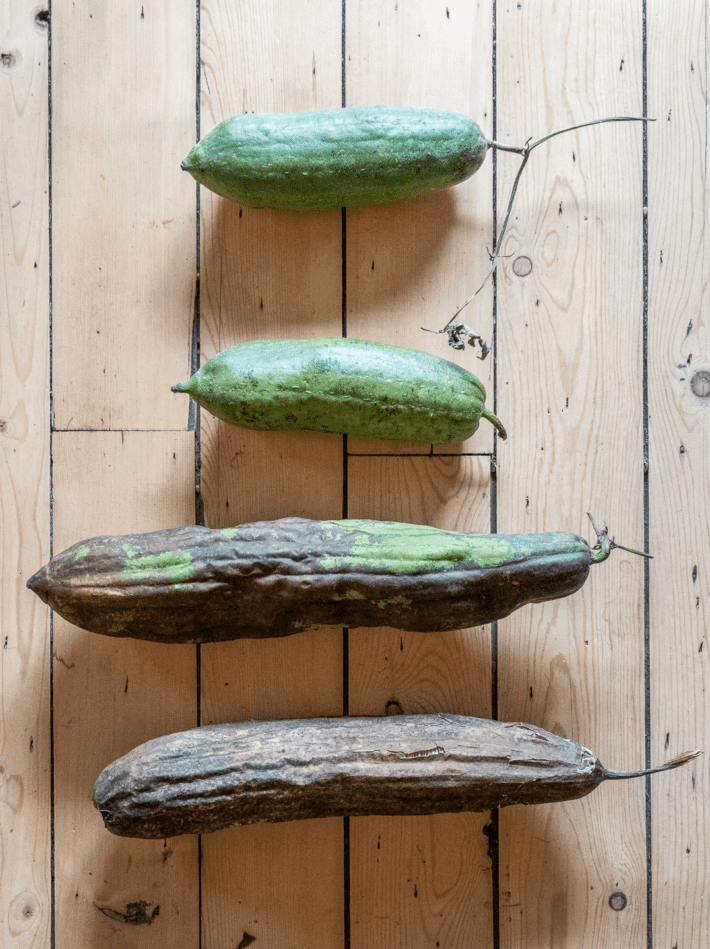
- 1st luffa is immature with spongey flesh inside.
- 2nd luffa is lighter in colour and weight which helps you know it may have developed fibres.
- 3rd luffa is well on its way to drying out and will definitely have a luffa sponge inside.
- 4th luffa is the ideal time to pick. When it's completely dry and you can hear seeds rattling inside.
Like I said, it isn't easy and definitely not for the half assed gardener in colder climates, but if you really want to grow loofahs you can.
Peeling, Processing & Preparing
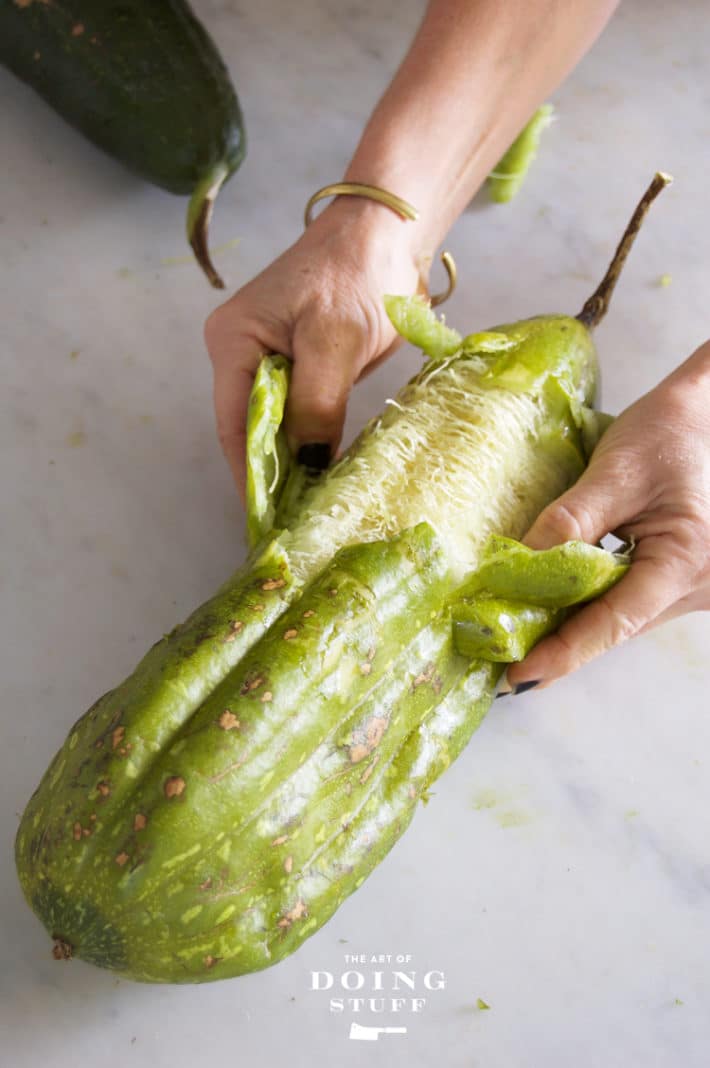
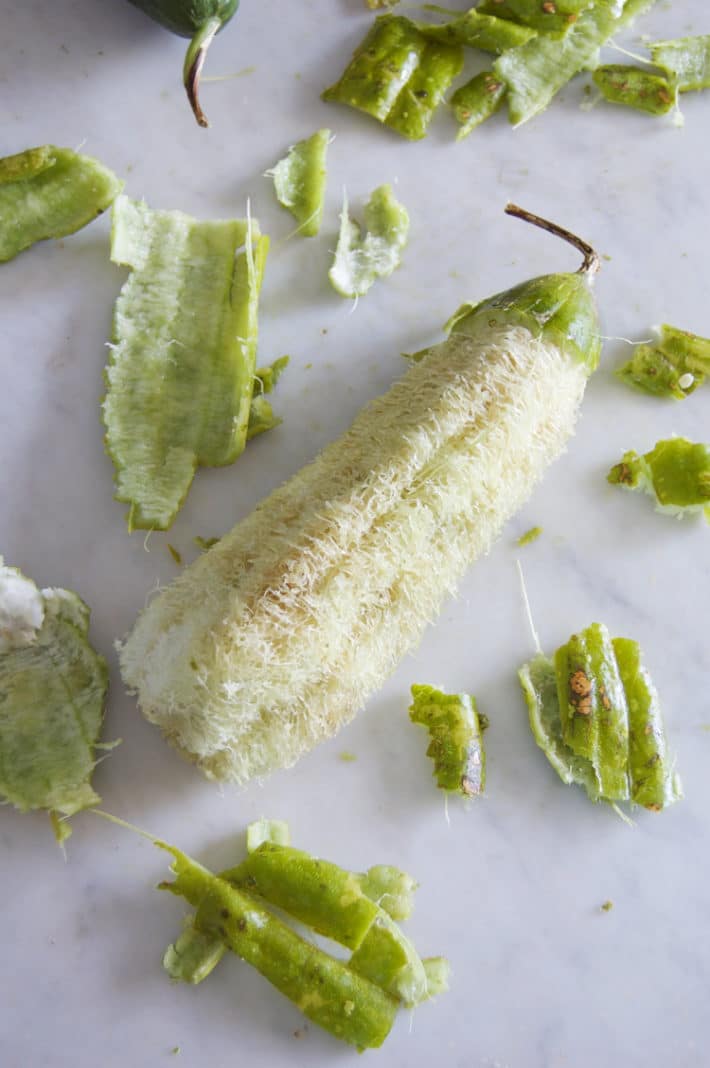
How to process immature (green) luffa
- Lay the gourd on a hard surface like a table. Press down hard on it with the palms of your hands to crack the skin. Do this many times until much of the skin is cracked.
- Press your thumb into the skin by a crack pushing down until you can worm your thumb under the skin. This will separate the skin from the sponge fibres. Kind of like how you would peel an orange that doesn't want to be peeled.
- Rinse the sponge under water once it's released. Squish any wet gooey parts out while you rinse. You want the sponge to be perfectly clean.
- While you rinse and squish, many of the seeds will come out. When it feels and looks clean, let it sit on the counter overnight to dry.
- Once dried you can shake and bat your luffa around to get the remaining seeds out. They'll come out much more easily once it's dried.
- If you'd like a brighter looking sponge you can soak it in a solution of 1 part bleach and 10 parts water. After bleaching, rinse it with clean water and let it dry again.
note: I have quite literally never measured my bleach solution. I just fill the sink with water and glug some bleach into it. But rules are rules and the rule is 1 part bleach to 10 parts water.
Peel green loofah as soon as you pick them. Don't wait for them to dry out - they could rot and discolour.
Saving Loofah Seeds
Each luffa will be FULL of seeds that you can use to grow more luffa next year.
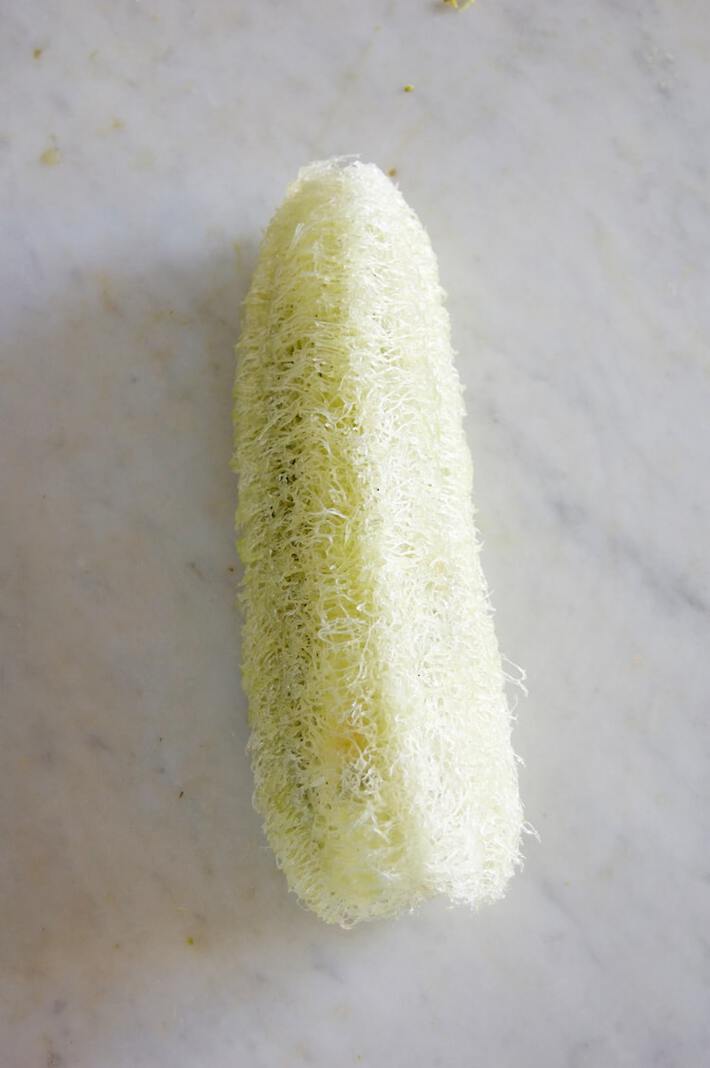
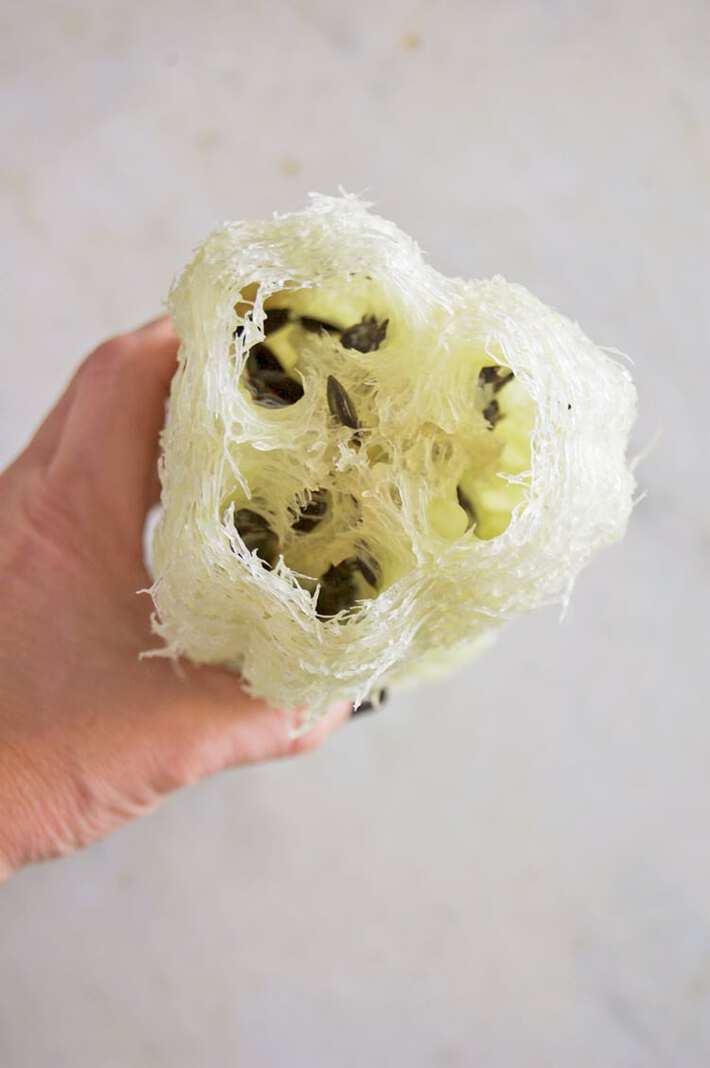
- ONLY the black seeds are viable. White or light coloured seeds will not germinate or grow.
- Once you've set your black seeds aside, feel them. Some will be fat and some will be flat. Fat seeds have been properly pollinated. Flat seeds have not been pollinated.
- Only the FAT luffa seeds will germinate, so those are the ones you need to save for planting.
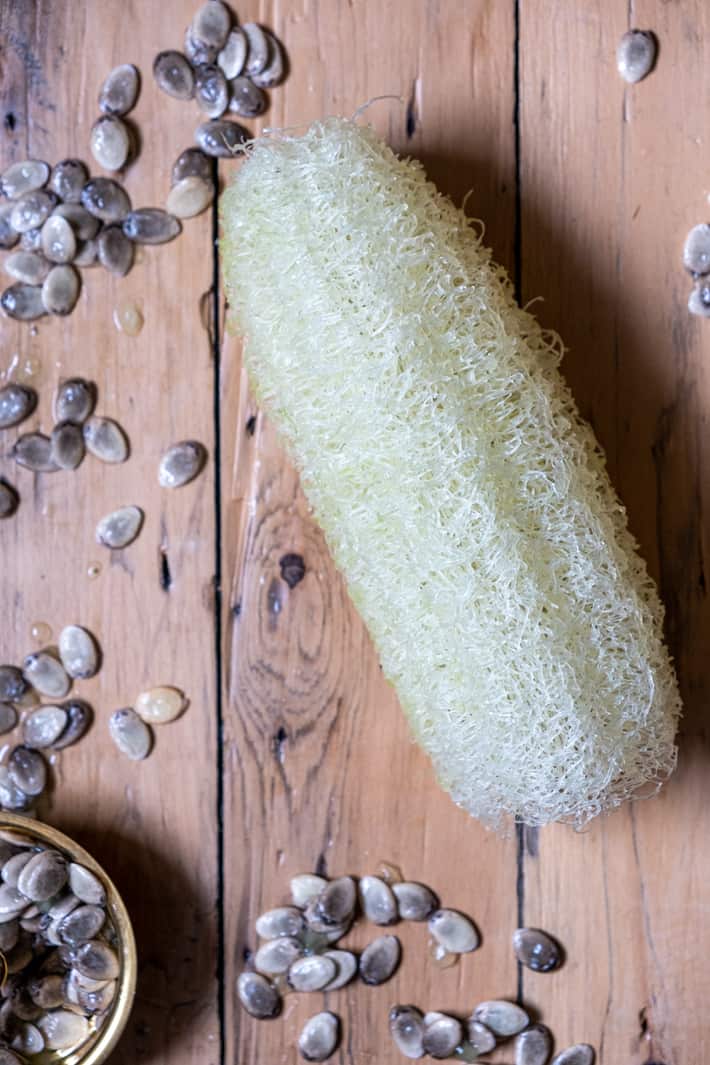
What is a Luffa Sponge Used For?
- In the shower. Either soap up yourself and slough away dirt and dead skin with the Luffa or cut a bar of soap so it fits into one of the luffa channels and it will lather as you scrub with it!
- Pot scrubber. I keep a bowl of these cut into 3 or 4" lengths and use them to scrub pots. When they get dirty they go into the dishwasher. If there's no hope of them getting clean because there are so many bits stuck in them, they go into the compost bin.
- Removing gummy glue from removing stickers off of plastic or glass. Just dab the sticker with oil then scrub with a luffa. Although truly, the best way to remove any sticker is with a hairdryer.
- Anything that needs cleaning by scrubbing.
- Vegetables! Luffas are the BEST vegetable scrubbers.
How to Clean Them
- With bleach in the sink.
- In the washing machine.
- In the dishwasher.
- To maintain the luffa make sure after using them you allow them to stand on end so they can dry properly. Otherwise they'll get musty and gross.
Luffa sponges NEED to be cleaned, especially if you're using them in the shower. Once a week throw your luffa into the wash or soak it in a bleach solution. 1 part bleach-10 parts water. Let it soak for a few minutes and then rinse it.
Where to buy seeds
I got my original seeds from William Dam Seeds in Canada. In the US Baker Creek would be a good place to get them.
Start to finish you're looking at around 6 months or 180 days. The length of time it takes depends on the variety of loofah, but generally it's about 6 months from the day you start your seed to the day you're picking the loofah.
In warm climates you can expect to get 6 sponges from 1 luffa plant. But in colder zones you may only get 3 or 4.
In climates with long growing seasons and in full sun. But they can be grown in cool climates if you use this guide.
If you're a soap maker, you can slice a sponge and put it in the mould before pouring your soap solution. Once it cures you'll have the absolute BEST shower buddy. If you don't count Idris Elba, who of course would be an even better shower buddy.
Yup. But not only are the luffa fruit edible, but the leaves are as well. Just make sure you pick them as a leafy green when they're young. As they get bigger and older they get tough.
If after all of this you've decided you'd rather grow something a little more reasonable, but still fun, I'd recommend growing Buzz Buttons™️ aka toothache plant.
So there. Now I've told you how to do it. Yes I know this post was long, but consider yourself lucky it wasn't a decade.
→Follow me on Instagram where I often make a fool of myself←
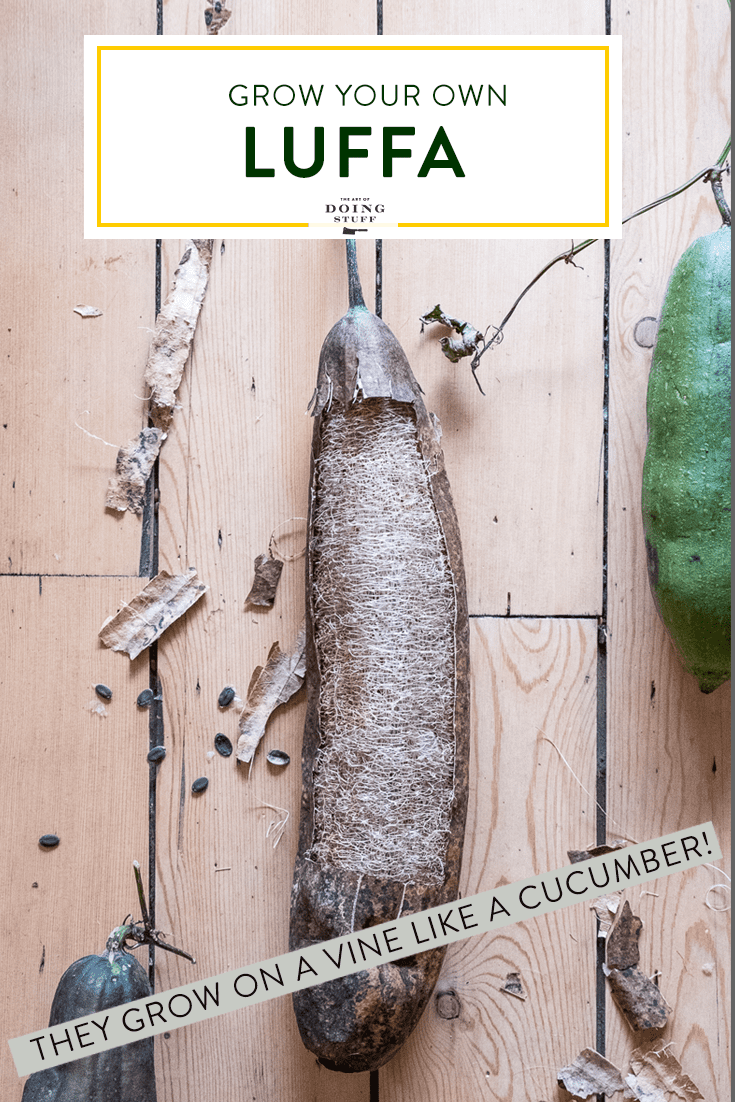

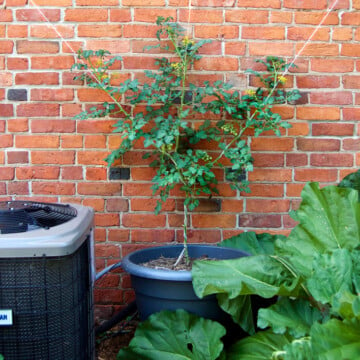

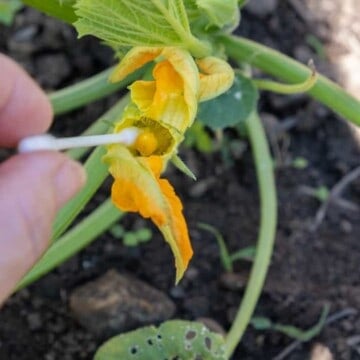

Please register my thanks/ and interest in your horticulture advice
Thanks
now i know why i've been dragging my feet trying to grow them. i figured, let Karen figure it out first and from the sound of it, YOU TOTALLY DID. i'm in Maine so that'll be a dicey undertaking, but it ain't gonna stop me. as soon as i hit the SEND buttom i'm off gathering supplies. you got a few good guaffas in that one. bloody love it.
onward and up
Karin
Oh! My hero! We are sooo lucky, inasmuch as we have only wasted 3 years on attempting to grow luffasses in New Brunswick. Yes, that's what I call them now after 3 years of increasingly pretty vines, but no luffasses. This will be our 4th year and I finally have hope! The first year was ''Ooooh! This is exciting!". Second year: "Maybe we didn't do it right last year. This year will be better!" 3rd year "Those bloody things better grow!" This year "well, we might as well use the seeds we have." ONE has germinated and looks cute. I think we will buy more seeds. I make soap and they would be the perfect accompaniment, so fingers crossed for this year! Thank you so much for this - perfect timing :)
So, I grew some luffas that turned out to be small-- as in 1 foot long, no bigger. No problem; it was my first time growing them, I had no idea what the seeds would produce. Turns out that small mature luffas have a VERY fine grain to the spongy bits. I wouldn't want to use a big luffa on my face, too rough and grating, but these little ones (about 3" thick) make amazing dermal scrubbers with a nice cleansing cream. They've done my skin a lot of good! Also, I live in Tucson AZ, and Tohono Chul (a local public garden, footpath area and Native American educational center (it also has an *amazing* restaurant) grows tiny little luffas that are no more than 4" or 5" long. I recently read that luffas came to North America possibly as far back as 9,000 years ago, so I'm guessing these are as close to native luffas as they get.
Thank you!
Just ordered my seeds!
Good luck! ~ karen
Oh, Karen. Your blog is such a problem for me!!!
I have my own ever growing List of Things I Am Unlikely to Accomplish, then I come here and suddenly want to add loofah farming, butterfly cultivating, and cherry tart making to the list.
You make it all sound fun and sooo interesting (plus damn funny…and i loooove funny)!
If it will help you I will write all of my posts in a most sombre tone from now on. ;) ~ karen!
Thanks, Karen! I was just thinking of trying my hands at growing luffa this year and you immediately came up with exactly what I need: a guide. Know how to read minds even from a distance, eh?! 😀
It's my superpower. Knowing when to nudge people to think about gardening, lol. Not quite as flashy as flying or superhuman strength but still useful. ~ karen!
What a great article!
My mom enjoyed reading your posts so much! I know exactly what would have happened this morning if she was still here…I would get a call and she would want to know if I read about growing loofah’s. She would be ordering the seeds and planning where to plant them. I would be jealous because I live in the city and don’t have a place to grow them. The next 6-8 months would be filled with updates on the loofah growing progress. And I would love every conversation.
Thanks Karen! I feel like I just spent a few minutes with my mom…❤️
Thank you for writing an excellent guide on growing loofahs. I also live in Zone 6 (central Ohio, USA) and just on a whim bought a loofah plant last spring from a local greenhouse. I didn't really know anything about it but thought it might be fun. I planted it and waited. Growing loofahs is really a waiting game. Wait for them to grow; wait for them to flower; wait to see actual loofahs. Makes it more exciting when things start happening - especially for geeky gardeners like me!
While I waited, I researched online how to grow them and harvest them. Watched several Youtube videos. The info from them saved my loofahs. I did harvest about a dozen green loofahs. Hand-peeling gives your hands quite a workout!
This spring I plan to purchase 2 plants. I will also provide more space for them to climb as they really grow 20-30 feet each. I will be retiring soon so I will have more time to make loofah soaps, etc. for gifts.
Hi Nancy. Yes, they really do, lol. They're huge plants. And peeling a whack of green ones really can be a bit painful by the end, but it's so satisfying and exciting that I don't mind. ~ karen!
I loved reading every word of this post, Karen, and I don’t think I will ever grow anything - let alone an asshat loofah! 😂 I love your humor, and this hit the spot! The Thanksgiving story was golden! Happy loofah-ing, everyone!
Thanks Patty! Yes, it was a Thanksgiving to remember. ~ karen
We live on the west coast of BC, near Queen Charlotte isl, we get a lot of rain. So was wondering if you could grow in a heated green house?
We are going to be hit with 2 days of overnight temps of 32 degrees and then warm again. The daytime temps are in the upper 50's and low 60's. Do you think I need to pull all my loofahs? They are not ready yet. Some are really heavy and starting to change colors. However I do not think they are ready to peel. I'm hoping to leave them on another 2 weeks
A frost hit here last night. I picked 11 sponges because a hard freeze is coming in two days. What do I do ? Do I let them freeze? Do I bring them all in. I am thinking there are close to 30 out there in various sizes. ????????
Have you peeled a green luffa and had any fleshy part of the squash intermixed with the sponge, and if so, do you dry it out, will it make a useable sponge?
Thank you so much for this article. I'm on my third year of trying to grow them in zone 7a and your post is encouraging me to not give up. I also appreciate the information that you can harvest them while they are still green - I might get a few this year. I will be sure to remove any late blooms next year. I make soap sometimes and would love to put luffas I grew in some bars to give as gifts.
Has anyone successfully grown these indoors?
Not really indoors but in the polytunnel. I live in central France which is about equal to zone 6 in the US.
This is only my 2nd year of trying to grow loofah. Year 1 was a total failure. Year 2 I got 3 loofahs.
I planted late in March 2021 but I think earlier would have been better. The vine grew to approx 8 metres (approx 26.25') and I had 3 small but reasonably successful fruits. Although we have had frosts it doesn't really get inside the p/tunnel - just COLD. I harvested on 1 Jan 2022 and have 2 useable sponges. The 3rd my partner wants to keep to show to a French friend who had never heard of loofahs before.
This year I have already started my seeds on tissue above the water heater.
Hi
What is the clear sticky Substance on my luffa (and now in my hair!!!) Honeydew???
1st year growing luffa (in UK no less.. I love a challenge). By what I can see, I have 1 female bud in a forest of boys but the female hasn't bloomed and looks to be turning yellow?
So after reading your blog on this I decided to give it a try (located on Long Island, NY). My vines are growing happily but I haven't seen a flower yet. There seem to be a lot of ants attracted to the vine and hang out in all the crotches of the vine where I would think the flowers would be produced. Do you see this in your plants? Wondering if the ants are actually eating the buds and going to keep my luffas from producing anything.
Hi Lori! It's unlikely that the ants are eating the flowers. They do like climbing on the vines though. You're on track for luffa. Don't forget that it's a plant meant for a much hotter, much longer summer we have. So it takes a lot longer for it to develop everything, including flowers. As long as it's in full sun and you water it, they'll come. :) ~ karen!
please subscribe me- thanks